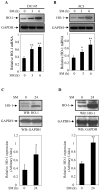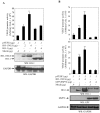Cigarette smoke induces nuclear translocation of heme oxygenase 1 (HO-1) in prostate cancer cells: nuclear HO-1 promotes vascular endothelial growth factor secretion
- PMID: 23591596
- PMCID: PMC3699615
- DOI: 10.3892/ijo.2013.1910
Cigarette smoke induces nuclear translocation of heme oxygenase 1 (HO-1) in prostate cancer cells: nuclear HO-1 promotes vascular endothelial growth factor secretion
Abstract
Prostate cancer is the second leading cause of male-cancer related death in the United States. Despite a number of evidence-based studies which strongly suggest an association between cigarette smoking and prostate cancer, the underlying biological mechanism is largely unknown. Heme oxygenase 1 (HO-1) has been implicated in maintaining cellular homeostasis, but also in tumor angiogenesis. Nuclear HO-1 protein expression has been observed in various types of tumors including prostate cancer. These studies, however, were reported as clinical and pathological observations, and failed to investigate nuclear HO-1 at the molecular level in cancer. The present study explores the relationship between cigarette smoke and nuclear HO-1-modulated promotion of vascular endothelial growth factor (VEGF) secretion. We have demonstrated that cigarette smoke medium (SM)-induced HO-1 mRNA expression and upregulated HO-1 protein levels in the prostate cancer cell lines DU145 and PC3. We also observed that SM significantly induced nuclear expression of HO-1, and enhanced secretion of VEGF in cells. Nuclear-directed expression of HO-1 activated the transcriptional activity of VEGF and promoted VEGF secretion in prostate cancer cells. This study provides new insights into the molecular mechanism by which cigarette smoke-induced nuclear translocation of HO-1 promotes VEGF secretion in prostate cancer cells. Nuclear HO-1 may, therefore, constitute an attractive therapeutic target to inhibit angiogenesis and the progression of prostate cancer.
Figures







References
-
- Siegel R, Ward E, Brawley O, Jemal A. Cancer statistics, 2011: the impact of eliminating socioeconomic and racial disparities on premature cancer deaths. CA Cancer J Clin. 2011;61:212–236. - PubMed
-
- Pryor WA, Stone K. Oxidants in cigarette smoke. Radicals, hydrogen peroxide, peroxynitrate, and peroxynitrite. Ann NY Acad Sci. 1993;686:12–27. - PubMed
-
- Hecht SS. Tobacco smoke carcinogens and lung cancer. J Natl Cancer Inst. 1999;91:1194–1210. - PubMed
-
- Portal-Nuñez S, Shankavaram UT, Rao M, Datrice N, Atay S, Aparicio M, Camphausen KA, Fernández-Salguero PM, Chang H, Lin P, Schrump DS, Garantziotis S, Cuttitta F, Zudaire E. Aryl hydrocarbon receptor-induced adrenomedullin mediates cigarette smoke carcinogenicity in humans and mice. Cancer Res. 2012;72:5790–5800. - PMC - PubMed
Publication types
MeSH terms
Substances
Grants and funding
LinkOut - more resources
Full Text Sources
Other Literature Sources
Medical

